Deciding to get a pet snake can be a fun and exciting experience for any age.
Whether you are an aspiring herpetologist, looking to join the existing 4.5 million households with reptiles, or are a more experienced handler looking for a beginner snake, this list will help you find the perfect one.
Snakes are very different from companion animals and livestock. Because of this, they have very different husbandry and care requirements. Choosing a beginner snake can be a tricky process. You need one best suited for your care and handling capabilities.
In this article, we discuss the top 20 pet snakes that can be handled by beginners based on ease of care, cost, and temperament.
20. Smooth Green Snake
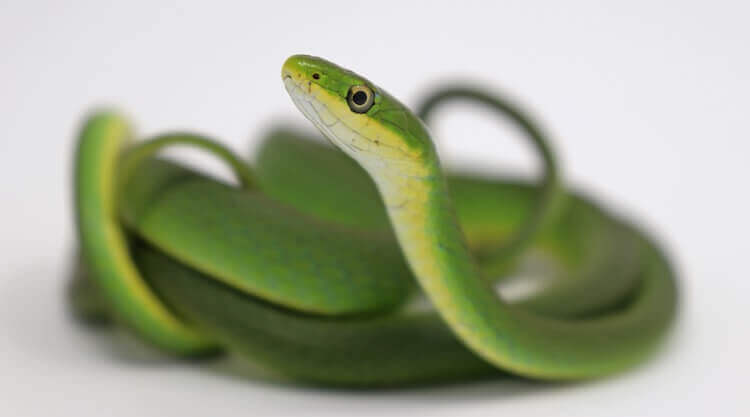
This snake, like the rough version, is native to North America and has a very skinny frame.
It can be housed in a small enclosure (e.g. 10 gallon vivarium) and fed insects, but it doesn’t tolerate handling very well for long periods of time. They are best suited to someone who wishes to keep a reptile more as a display animal than a companion.
The Smooth Green has similar care requirements and temperament to its relative the Rough Green Snake (also featured in this list). What makes this pet rank lower on the list is its availability.
They are harder to come by as captive bred animals. There are only a handful of breeders and wild caught (as well as being illegal to keep) can be more problematic for many reasons.
If you are a beginner and manage to get a hold of a good Smooth Green, they can make a great choice.
Although they cannot be handled frequently, their small size makes for easy husbandry, quick feeding and a great learning experience. The longest it may live is 15 years, and their cost will vary depending on where they come from.
19. Ringneck Snake
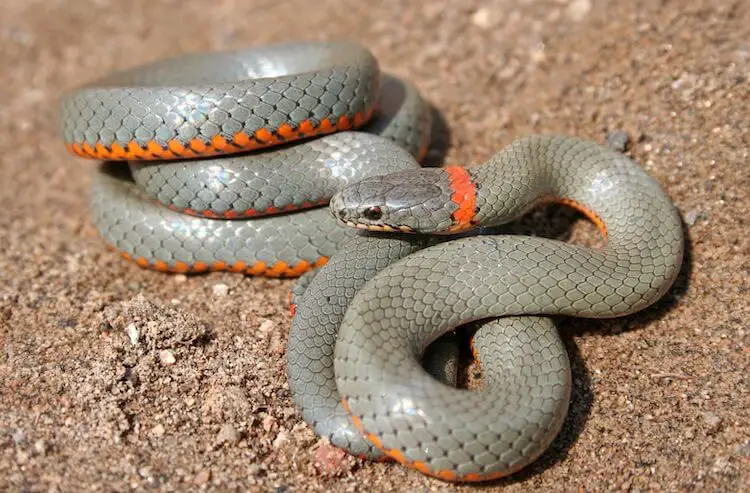
The Ringneck is another native snake to North America and has a distinct yellow or orange ring on their neck (as their name implies).
They are very small, averaging around a foot long.
These snakes commonly eat earthworms and need more husbandry (e.g. proper heating and lighting) than most others on this list. They are usually docile and tolerate handling for short periods of time; but may become irritated if they are handled for several minutes with no break.
Although they carry venom to harm their prey, this venom is not dangerous to humans. Their mouths and teeth are very small, so any attempts to bite your finger will be ineffectively harmful.
Because they are not as popular as other pet snakes, they are relatively uncommon. They can live around 10 years, but occasionally only live to 6 years in captivity, and cost between $10-$30 USD.
18. Rainbow Boa
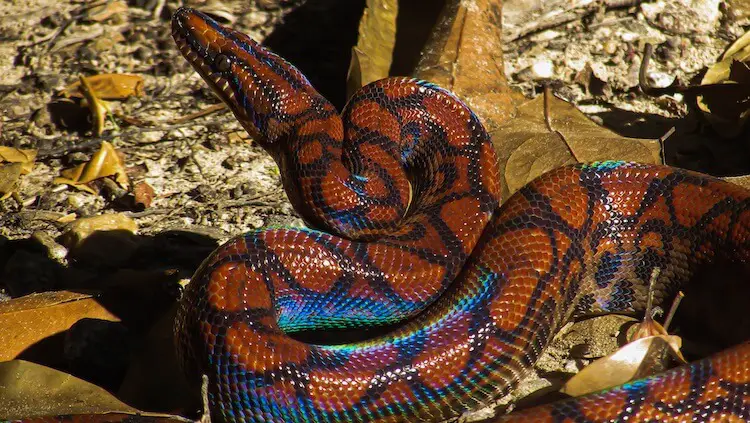
The Rainbow Boa is native to South America and is not usually recommended to beginners for its shy and nippy behavior, but has landed a spot on this list for its other redeeming qualities.
First and foremost, Rainbow Boas are widely known and appreciated for their stunning colors. In the right light, they have a shiny, iridescent gleam to their skin.
They require specialized husbandry and specific tank conditions of high heat and humidity because of their natural tropical habitat. They may be nippy and shy as babies, but the right Rainbow Boa can tame down as an adult with frequent handling.
They may be more high maintenance, but the reward of a gorgeous reptile is a high one if the right amount of time and patience is put into their care.
Best for a beginner who is ready for a big commitment and to learn about correct handling.
Rainbow Boas are typically 5-9 feet long and can live to be more than 20 years old. They are also one of the more expensive pets on our list typically ranging from $200-$600 USD. Some albinos and morphs can be as expensive as $2000-$3000 USD.
17. Carpet Python
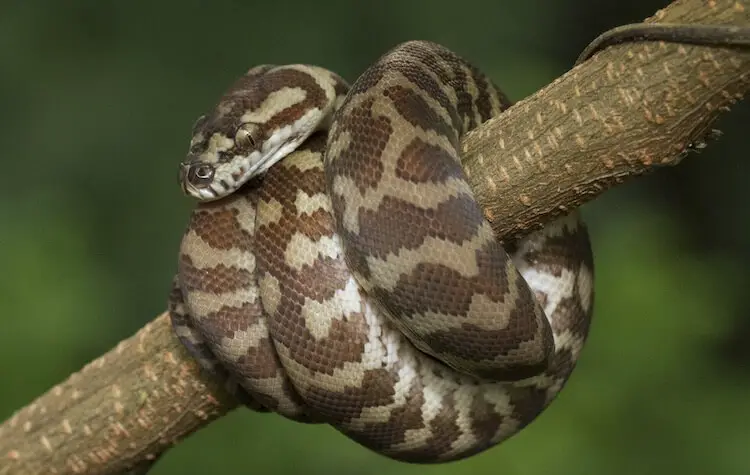
The Carpet Python is native to Australia and comes in a variety of colors and several species. This Python is a bit longer than most snakes, reaching 6-6.5 feet on average.
These snakes follow most of the same husbandry requirements as others on this list in terms of: temperature, lighting, and feeding. They will need high temperatures, regular lighting, and eat rodents.
Baby and juvenile Carpet Pythons tend to be very nippy, but if they grow up being handled frequently, they tend to be more tolerant as adults.
It is for this reason that some beginners like to start with a tamer choice, but this isn’t to say that a good Carpet Python won’t be a good pet for most.
Most beginners love them for their great variety of colors. They live up to 20 years and generally cost between $100 to $300 USD.
16. Cape House Snake
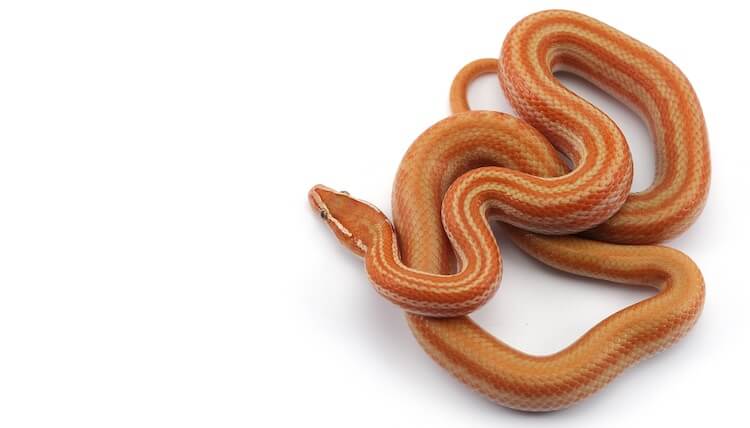
The Brown House is native to Africa and is a length of between 2-4 feet long. They eat mostly rodents and have the basic care and husbandry requirements of most other snakes.
While not an overly popular choice, the Brown House is a great beginner snake and generally costs $60-$150 USD.
They generally have good dispositions and are easily handled after they have been acclimated to their new home. They’re not overly large, so if they do bite, it should not be a dangerous one.
Unfortunately, they do have a shorter lifespan, typically living for only 8 years.
15. Dekay’s Brown Snake
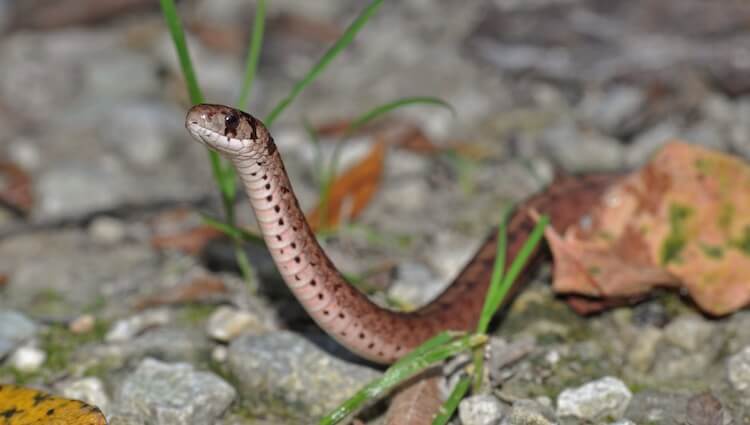
Though not thought of by herpetologist as a great first snake, many experts agree the right Dekay’s Brown can make a great first snake for any beginner.
Their habitat does not need to be as large as the tanks of other species because of their small size (barely reaching a foot long).
This species is found throughout North America and does not require high temperatures making their husbandry very easy. Dekay’s Brown Snake is a naturally curious species, and they are usually not stressed by human activity or handling.
Because they are so little, they eat insects and earthworms rather than small mammals.
Overall, the husbandry of this pet is on the easier side, depending on your management style, and they tolerate infrequent, gentle handling. They are certainly manageable for a beginner with the right husbandry.
14. African Egg-Eating Snake
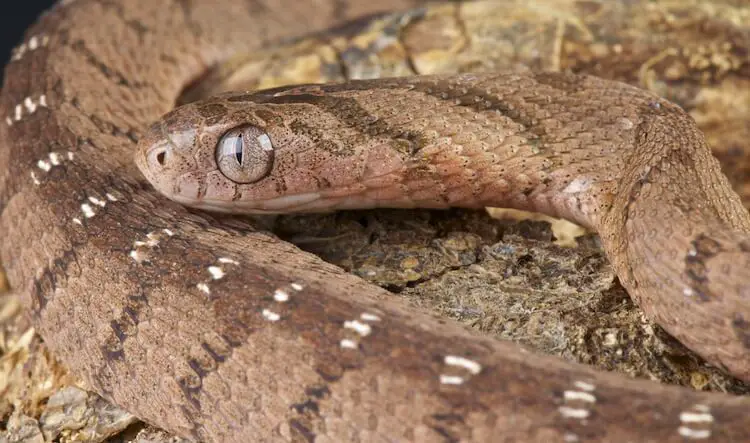
The African Egg-Eating Snake, as its name suggests, feasts on bird eggs and nothing else.
This is a rare and very specific feeding requirement. It is one of the few disadvantages of owning this snake.
This species is not terribly large, spanning 2-2.5 feet long, and they range throughout most of Africa.
Feeding this snake in captivity is one of the most difficult parts of their husbandry. They should have finch or quail eggs as chicken eggs are too large. However, this may bode well for you if you do not want to feed rodents.
They come from arid environments, so they do not need to have high humidity like most species. Other than this, they have a passive manner of defending themselves, relying on mimicking the colors of more dangerous reptiles rather than attempting to bite.
It is impossible for them to bite and harm a human.
Once they have been handled frequently, they are calm, docile, and are easily handled by a beginner. They live up to 15 years and generally cost $60-$160 USD.
13. Rat Snake
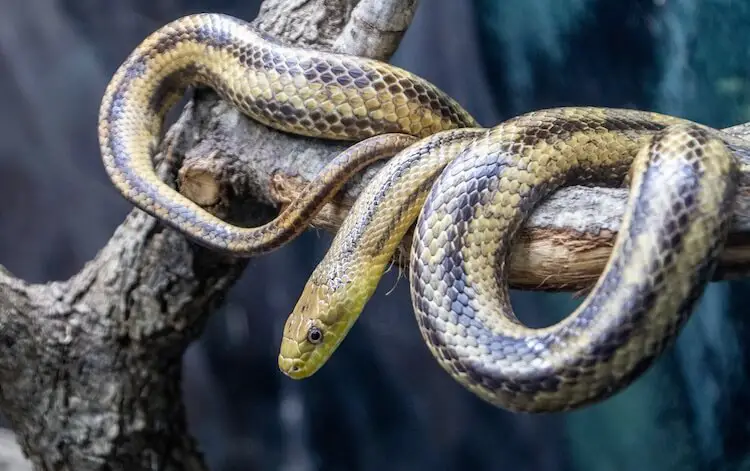
The Rat Snake, though not as popular, is very closely related to the Corn Snake, sharing the same genus Pantherophis.
Average sized, reaching 3-5 feet, they are commonly found throughout the United States. They commonly eat rodents and tend to live in wooded areas or in barns.
When they are afraid, they “play dead” and lie motionless instead of striking.
Like their Corn Snake cousin, they are very shy and docile, especially if they are handled regularly. They also don’t have as much of an affinity for heat. While they should still have high temperatures in their tank, room temperatures will not harm them.
This docile reptile is easy to care for and can be a great beginner snake for any age. They can live up to 30 years and generally cost between $30-$300 (depending on the morph).
12. Children’s Python
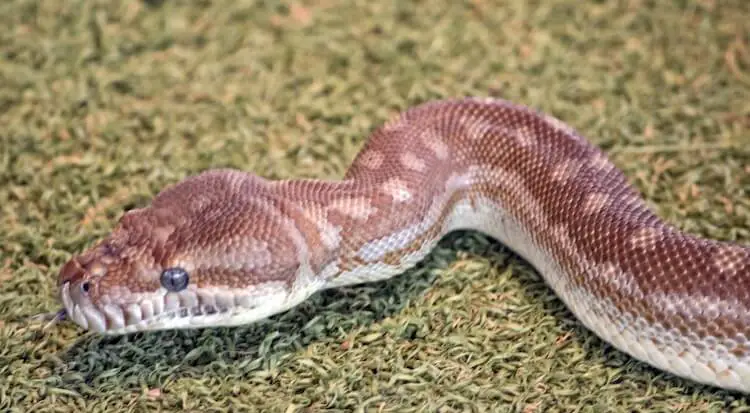
The Children’s Python, named by the zoologist John George Children, is a medium-sized python about 2.5-4 feet long that inhabits the rocky areas of Australia.
This reptile is basic in its care requirements and eats mice or rats.
They are not as colorful as many on this list, but they can make great pets as they have little extra care requirements and have stable temperaments, especially if they are handled frequently and gently.
Children’s Pythons can absolutely be handled by beginner herpetologists. They can live up to 30 years and generally cost between $70-$350 USD (depending on where they come from).
11. Rough Green Snake
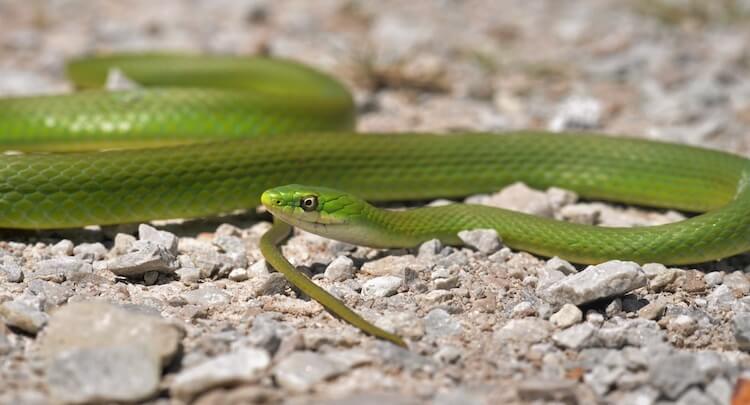
This slender reptile is native to the southeastern US and northeastern Mexico and can be quite long for their little bodies, reaching up to 2.5 feet long.
They are most often found in forested areas. Unlike most pet snakes, rodents are too big to swallow for these reptiles, so they like to eat insects and spiders. In terms of general husbandry and feeding, this snake is easier to care for than others.
Rough greens can live up to 15 years, though many in captivity don’t live that long.
While this species is tiny and may be physically easier to handle, they do better in a home where they do not have to be handled as often, as they can become stressed and scared.
They are a great choice for beginners who would like to learn about the basics of caring for a snake and keeping them clean and healthy, but not so much for someone who wishes to frequently handle their snake.
10. Common Boa Constrictor
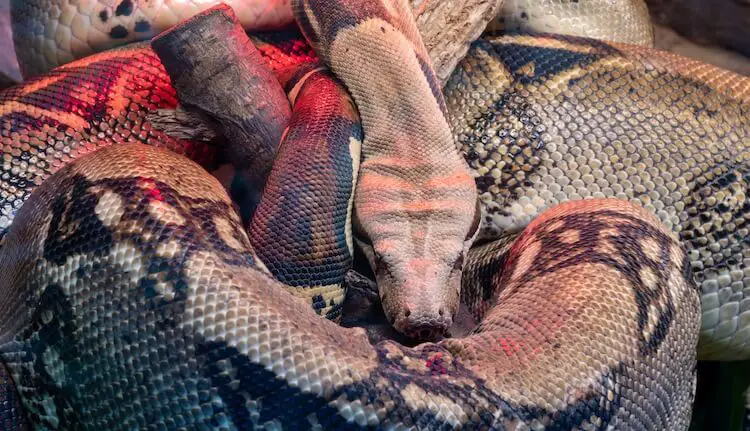
The reason Boa Constrictors are not usually recommended to beginners is because of their very large size, reaching a whopping 13-16 feet long! They need a confident handler who is strong enough to hold them.
However, this is not to say that this Constrictor doesn’t have the potential to be a good beginner snake.
This Boa spans through most of Central and South America. In the wild they eat deer, fish, lizards and other animals. But in captivity they can eat rats, rabbits, or chickens (depending on their size).
They have the same general care requirements as most snakes, except they will require a bigger enclosure to accommodate their size.
Boa Constrictors are often tame when they are handled frequently, but they are also very strong and may coil themselves tightly around you if they feel threatened.
Because of their large size, this snake is more suited to adult beginners than children.
They are tame and tolerate handling if it is done frequently, and they have the potential to be a great pet. They live up to 30 years and can cost between $60-$200 USD.
9. Kenyan Sand Boa
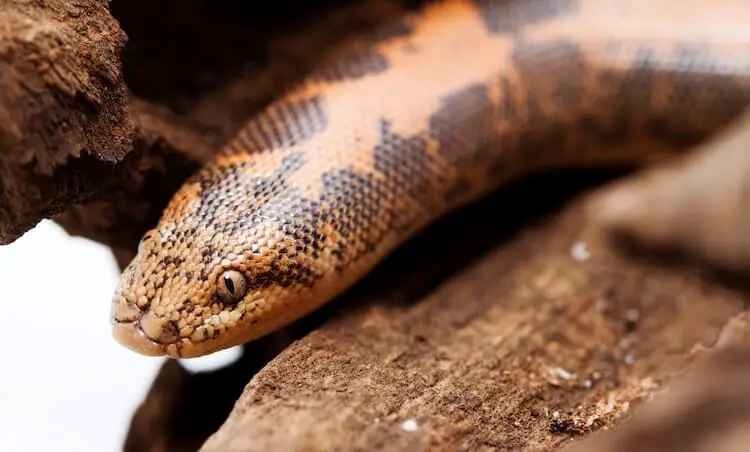
The Kenyan Sand Boa is known for burrowing into the sand, which is exemplified by their aerodynamic shape and smooth scales. These boas also use the sand to suffocate their pinky mice prey.
This Boa likes heat and needs a warm tank.
One thing that these reptiles, need that others don’t, is several layers of sand on the bottom of the tank for burrowing. This means that the tank may be harder to clean for beginners than a tank with simple substrates (e.g. newspaper).
The Kenyan Sand Boa is on the smaller size, reaching just a little more than 2 feet in length.
They are relatively even-tempered snakes, and would rather squirm away than bite if they don’t want to be handled. They can occasionally be feisty, but the right sand boa can make a great snake for a beginner.
Typically costing $75-$200 (depending on the morph), they can live up to 20 years.
8. Western Hognose Snake
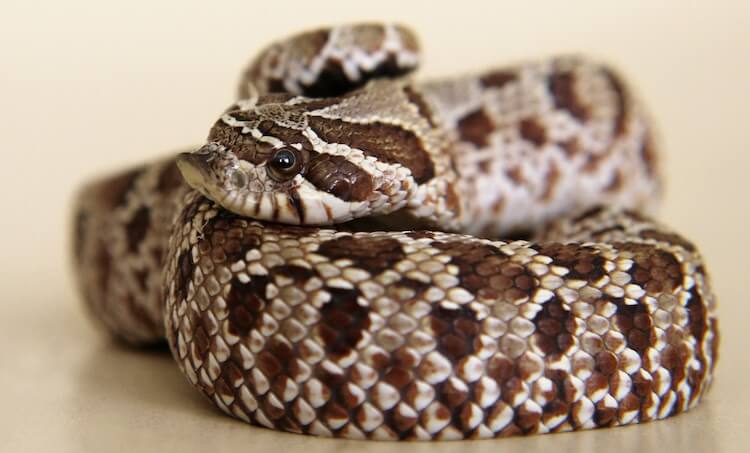
The Western Hognose is native to western parts of the US, as well as southern Canada and Mexico.
They are distinctly known for their upturned noses and are active mostly in the morning and the evening.
In the wild they often eat smaller lizards and toads. They like to dig holes in the ground to look for toads buried in the sand, but will eat mice in captivity if toads are unavailable.
Western Hognoses flatten their heads and hiss when they feel threatened. They may strike, but they are also known to never bite (even when they feel the most threatened). They would rather play dead.
The hissing they make when threatened is not an aggressive behavior and they tolerate handling very well. They are expensive as a first snake ranging from between $100-$700 USD.
7. Garter Snake
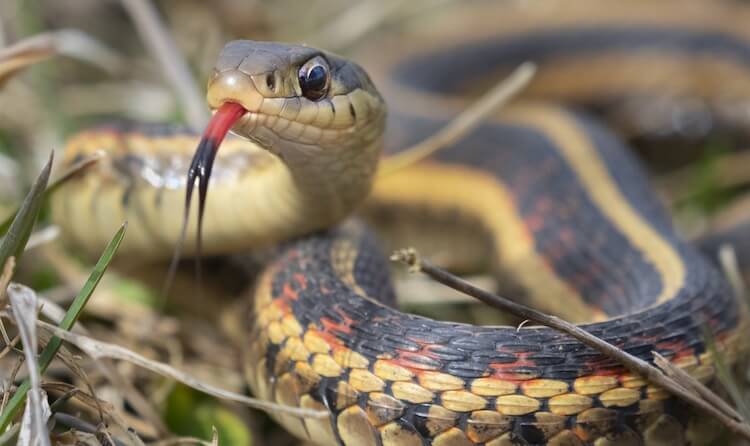
Garters are one of the most populous wild snakes in the United States, and you can also find them as a pet in many homes.
These snakes can be fed small fish and worms. Despite their rare diet, they have common lighting and heating requirements. On the smaller side, they typically reach 1.5-2 feet in length with some reaching four feet.
They have a distinct stripe running down their back and tend to enjoy meadows, marshes, and woodlands, so they enjoy a water source in their tank. They like to bask in the sun, so are one of a few beginner snakes which need a basking lamp.
Despite being widely known as a snake you find in your backyard (rather than a pet); the Garter Snake is actually a very popular in captivity too.
Even in the wild they are mainly harmless, and tame very easy. They are a great pet for beginners and are easily handled with their gentle and docile nature.
6. Gopher Snake
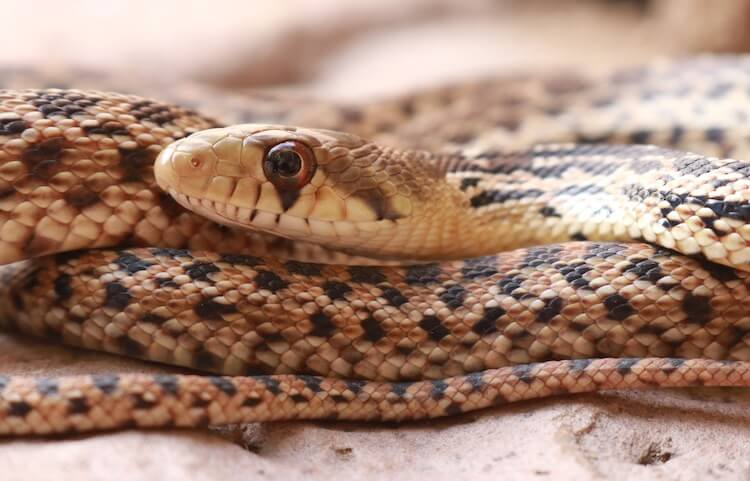
Also known as a Bull or Pine Snake, the Gopher is a reptile native to the western United States.
They are commonly mistaken for rattlesnakes, but beginners can easily tell the difference because they have a rounded nose and pupil, and don’t have fangs. This reptile can be either nocturnal or diurnal, but either way is very active.
These snakes are on the slightly longer side of many on this list, growing potentially to 4.5 feet long.
Like rattlesnakes, they will hiss and shake their tails if they feel threatened, but they are not venomous. Their bite can be painful, but they only bite in self-defense.
A captive bred and tamed Gopher should be calm to handle for beginners.
They live up to 20 years and like to bask in the sun, so they will require a basking lamp in their vivarium. They cost $90-$190 depending on if they are albino or not.
5. Milk Snake
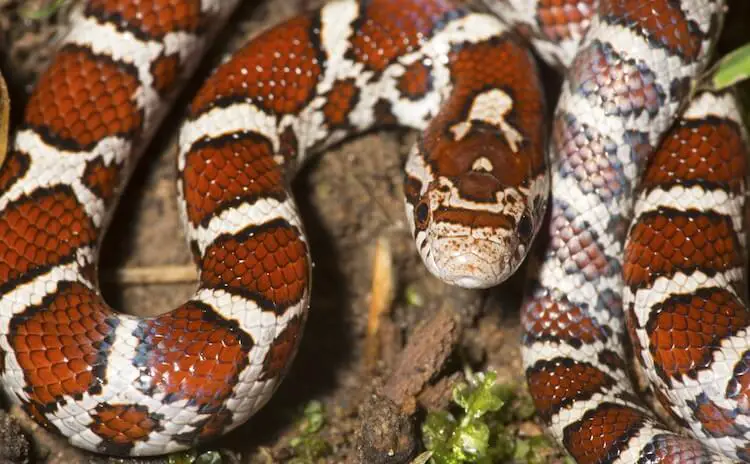
Like the California King (ranked #2 on our list), the Milk Snake is actually a separate species of the King Snake.
They are native to the US and Mexico and commonly have black, white, and red body rings.
Often found in the woods or rocky areas, they do not necessarily like to soak up sun, but rather enjoy soaking up heat from rocks and logs, so an under tank heater may be better for them. They otherwise have very basic care requirements and live up to 20 years.
Not very large, this reptile can grow up to 2 feet during their first few years.
Like other King species, Milk Snakes are very docile and rarely bite. They are certainly manageable for a beginner herpetologist and typically cost $50-$200 USD.
4. Rosy Boa
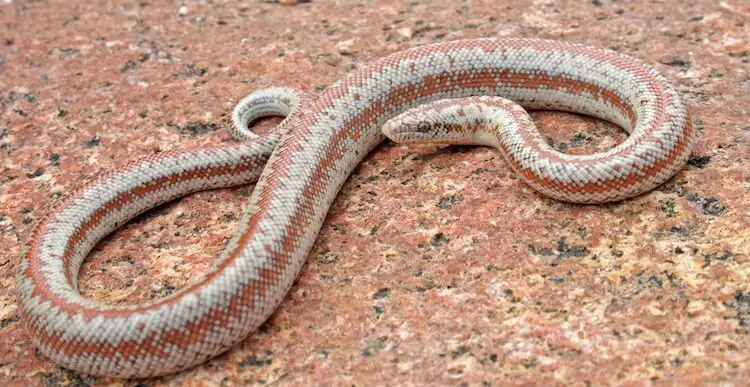
Rosy Boas are a brown-rosy-pink color and adjust to captivity very well. They are commonly found along the west coast of the United States and parts of Mexico.
Naturally curious, Rosy Boas hardly bite or strike and are certainly easy for beginners because they enjoy being handled.
They can live up to 30 years in captivity and can cost $25-$350, depending on if you get your snake from a public retailer or a private breeder.
Known for being a docile reptile, they are easy-to-care for and have simple husbandry requirements, butare not quite as popular as the top three snakes on this list!
3. Ball Python
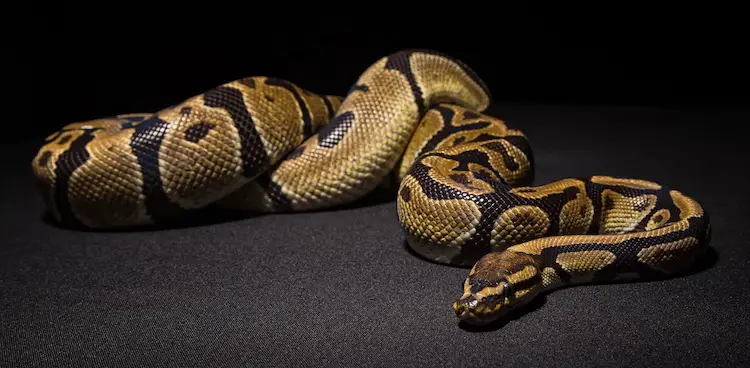
Ball Pythons get their name because of the “ball” they like to curl up in to feel safe.
Native to west and central Africa, they like to live in grasslands, likely burrowing in rodent burrows. They are active at night and like to stay hidden during the day.
They are typically brown with lighter patches, but captive-bred Ball Pythons come in a variety of colors. Adults are usually about 3.5-5 feet in length and can live 20-30 years.
Ball Pythons are docile creatures and are reluctant to bite. They prefer to curl up in a ball when they feel threatened. They will likely grow out of this behavior if they are handled frequently.
These Pythons eat mice, but it is their dietary-pickiness that makes beginner herpetologists wary. These pythons like to have their food served freshly killed or thawed.
They typically cost $25-$200, depending on the rarity of the morph. In general, Ball Pythons are a very common first snake, and aside from their occasional food pickiness, they have an easy care routine and are very tame to handle.
2. California King Snake
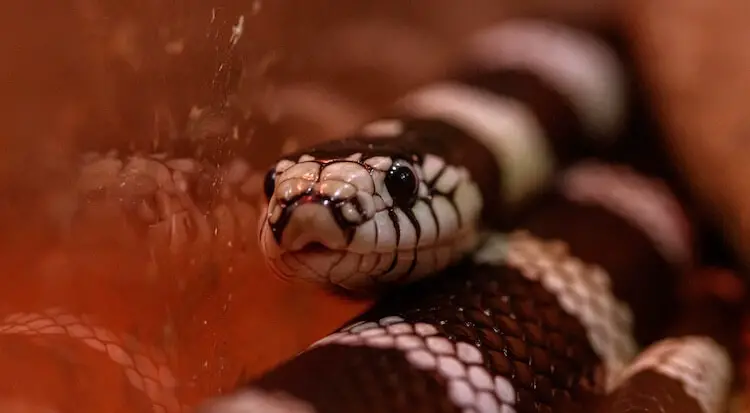
The California King is the most popular subspecies of King Snake.
Also native to the United States, they are typically a brown-black color with yellow bands, stripes, or speckles, growing to 2.5-5 feet long (about the same size as a Corn Snake). Unlike Corn Snakes, these reptiles are active during the day time instead of night time. They should, however, still have regular hours of daylight and darkness.
Great for beginners as they can be housed in a 20 gallon tank. They eat mice in captivity and can live up to 20 years.
This pet can be shy, but they are very docile with frequent handling. Instead of striking in anger when threatened, they would rather coil up to hide in defense. A reptile well-adapted to handling and living in captivity should not be afraid while it is being held.
These snakes generally cost $70-$170 and have basic care requirements with the benefit of being easy to handle with their calm temperament.
1. Corn Snake
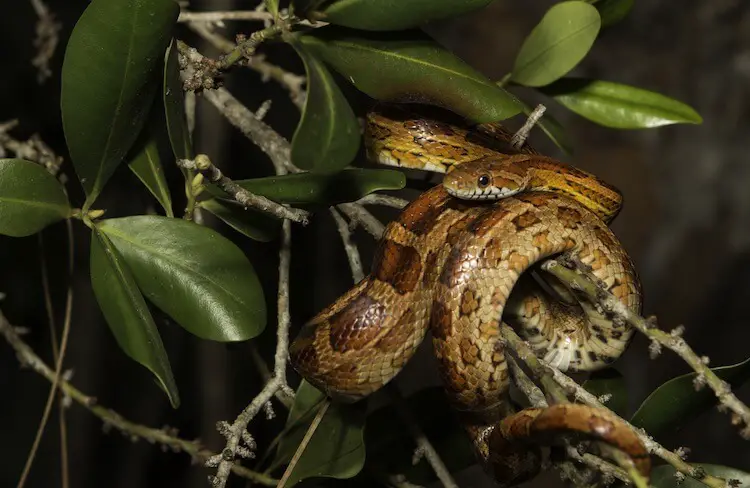
The Corn Snake is the most popular beginner snake.
Native to the United States, they can be found in terrestrial habitats. These snakes are red-brown to orange, typically with dark red-black blotches, but a variety of colors can be found in many captive-bred snakes.
Baby Corns are 10-12 inches long and grow to 3-4 feet long. They can be wild-caught (by professionals), but captive-bred are much healthier with better temperaments.
An adult Corn Snake can be kept in a 20 gallon aquarium, which is about the size of a medium-large fish tank, and the tank should range from 72℉ to 90℉ from one side to the other.
They have little extra lighting requirements, but are nocturnal so they should have hours of darkness.
Corn Snakes like to eat pinky mice in captivity. They present very few medical problems, and any issues typically only arise with poor husbandry. They can live up to 20 years and typically cost between $40-$100.
Overall, they have a very easy care regimen and a very gentle temperament that makes handling and taking care of them manageable, even for new snake owners!
Summary
There are many pet snakes in our list of 20 which are docile and easy to take care of making them great for a beginner!
If you are new to keeping reptiles, you should choose which one is the best for you based on your lifestyle (e.g. temperament, handling, appearance):
| Species | Easy To Handle? | Husbandry | Price |
|---|---|---|---|
| Dekay’s Brown | Yes | Easy | Inexpensive |
| Common Boa Constrictor | No | Advanced | Expensive |
| Ball Python | Yes | Easy | Expensive |
| California King | Yes | Easy | Expensive |
| Corn Snake | Yes | Easy | Inexpensive |
There is a reason why Corn Snakes and Ball Pythons are so popular; they are easy to care for, enjoy being handled and have simple husbandry requirements!
Whatever reptile you choose, you are committing 10-20 years of your life to this animal, and their lives are in your hands.
Let us know which one is your favorite and if you keep them.

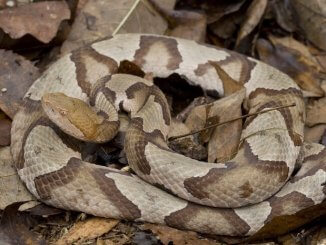
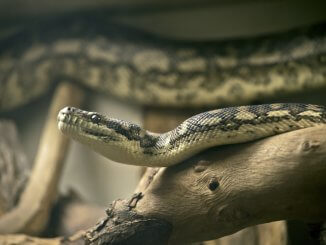
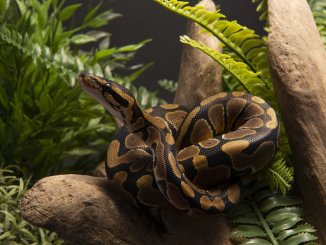

Jonathan
Could you please forward to me any smooth green snake breeders that you mentioned in your article?
I have been searching for a smoothie for a few years!
Thank you. Tom Gearhart
Hi Tom,
I’m not aware of any breeders in your area, but I have posted your comment in hope that a breeder can reply to it.
Would you suggest a rosy boa as a first snake?
I would certainly define it a beginner’s choice. Its size, requirements and temperament make it a good first snake, with only a couple of details that must be considered when caring for one. Head to our Rosy Boa care guide for a detailed look!
What is the best pet reptile for a first-time keeper who would like to handle his pet?
Hi Tim, if you want a snake then the Corn Snake is a great choice. If you are looking for a lizard then take a look at the Bearded Dragon or Leopard Gecko.
A Cal King is a good idea, if you buy it as a baby. With regular handling they’re so cute when exploring, and are not scared of you at all. I have a 10 month young now male aberrant that I have since he was 7 weeks old. He never bites or musks. He’s a sweetheart.
I’m looking into getting a rosy boa. I have loved snakes all of my life and have always wanted one, but this is my first one. I was wondering where the best place to get them from was, if the white ones require any different husbandry, and how big they get.
Hi Penelope, the best place to start is our Rosy Boa care guide.
i am ooking into getting a ringneck snakr
Hi there! I am a college student looking for an easy to take care of, legless companion, who likes to be held. This will be my first pet on my own, so a little guidance would be nice.
It’s really hard to argue with a corn snake as having the best balance of the best traits: hardy and easy to care for, long lifespan, docile and easy to handle, inexpensive (to buy, to house, and to feed), widely available, and with lots of unique and interesting morphs to choose from. They’re active snakes, but not overly so, both in their enclosure and when handled, and are most active at dawn and dusk. It’s hard to say that any species of snake “likes” to be handled, but corn snakes tolerate it well even without frequent handling. That said, anything on this list is unlikely to disappoint you, and the best one for you really depends on any other specifics you’re looking for. Rosy boas are probably a close second for these traits, but they do need a little more vertical space to be happy (both species like to climb, but rosy boas moreso), as well as more careful control over the humidity in their enclosure – rosy boas like it quite dry at all times.
I agree that corn snakes are a great first pet but I would also recommend a king snake I think they are a great snake
Just a note that the Children’s Python is definitely not a “medium-sized” python – it’s one of the smallest pythons in the world. It’s one of the five species in the genus Antaresia, which, out of ten genera of pythons, contains the smallest among them. Ball and carpet pythons (both of which are on this list) are much larger than Children’s Pythons and would be a better example of a “medium-sized” python, and they’re not even especially large snakes. A LARGE python would be something like a Burmese or Reticulated python – which, obviously, a beginner shouldn’t own.
Also pretty cool that it’s one of the few species of snake that people in Australia are allowed to keep.
hey i was wondering if you know of a good place/breeder to get dekays brown snakes
I recently got a beautiful Kenyan sand boa! It’s my first snake (though I’ve cared for snakes before). I didn’t have a ton of space for a large enclosure, and I wanted something I could handle easily. I’ve always loved sand boas, so I jumped at the chance to adopt a gorgeous, docile adult male (pretty sure he’s male based on his tail). He’s everything I could want in a snake! Easy to handle, minimal care requirements, as well as being extremely eye-catching and unique. I think sand boas are a great choice for anyone looking for an interesting and relatively low-maintenance pet.
I’m also a fan of ball pythons, as I have several friends who have them.
Howdy! I’m looking for a reptile/amphibian to keep. I am new to the amazing world of keeping reptiles/amphibians and I’m wondering if there are any reptiles/amphibians that are easy to maintain, don’t get too big, and have a shorter life span? Thank you! 😀
Like any other pet, reptiles and amphibians do require care. Don’t go into the hobby if you are unsure whether you can provide the best conditions and care for your animal.
Having said this, there are species that are relatively easy to maintain, handle and generally care for. Some beginner-friendly species with shorter lifespans and small size are Corn Snakes and Pacman Frogs, mainly because of their humidity, temperature, lighting and feeding needs. If you are not into frogs or snakes, you may go for a Leopard Gecko, but enclosure requirements are a little bit more complicated and average lifespan goes up to 18-20 years. Nevertheless, you are going to get your money’s worth in terms of interaction, for the geckos are more comfortable being handled and communicating with you.
I’m on the fence; currently debating between corn snake and trans pecos rat snake as a beginner pet. I REALLY like the pecos but wondering if the corn snake is less maintenance…?
Corn snakes are the textbook example of a beginner-friendly snake.
Their temperature, humidity and enclosure needs are quite easy to maintain, they have a mild personality and are easy to feed. Trans-pecos rat snakes are quite similar to corn snakes in these regards, and only have slightly more specific temperature and humidity needs.
Hi, i’ve never had a snake before, and i want to get a small, friendly,inexpensive, and social one that doesn’t eat rodents or anything like that. i have a local fishing shop with crickets and worms, so i think Dekay’s Brown Snake is a good choice. i live nowhere near and place with one though, and and and alternative recommendations would be great.I was also thinking about a Rosy Boa, but I also live nowhere near a shop with one of those. i don’t have much space and one who likes a small, or tall container would be best. Thank you!
Rosy Boa does eat small mammals ideally, so perhaps not your best bet.
The Dekay’s Brown is definitely a good option, and you can check other insectivorous snakes like the beautiful Rouh Green Snake or the common Garter Snake. If eggs are not a problem, then you have a list of egg-eating snakes that you can choose from. If you have size restraints you might also consider a Worm Snake.
CAN IT BE A CHICKEN EGG FOR THE AFRICAN EGG EATING SNAKE?
Our advice is to feed him smaller eggs first, especially if you have a young snake. For example, quail and finch eggs have been proven to be desirable food items for African egg-eating snakes. Fresh eggs work best, but if you only have access to frozen eggs, make sure they reach room temperature before feeding them to your snake. As the snake grows, you can start offering smaller sized chicken eggs and see how it reacts. They only eat once a week or every 10-12 days as they grow.
Where are smooth or rough green snakes available to purchase? I want to breed some. +Disclaimer+ Yes we know captive-bred is superior… but since doing this for 30 years basically (ok, out of the 36 yrs of my life, lol!), I’m now of the opinion that only ”seasoned” keepers should buy wild caught animals – with the intention of breeding them, whenever possible. Otherwise I wouldn’t necessarily do it. Anyway, I’ve only seen smooth green snakes on Underground Reptiles once, and rough greens at a few local stores (notably Pet Kingdom, San Diego CA). I just like their arboreal nature, and everytime I’ve been able to handle them, they’re just awesome to me. Also this list made me remember African house snakes, some cool morphs recently too. And apparently many different subspecies, localities, and varieties, like Namibian, Kenyan, South African cape, etc… thanks again!
Hii i love snakes, always have and I was thinking of getting one, but im still in high-school and I live with my mom and I doubt she’d let me get anything big so I was wondering what snake would be best if I want something as small, cheap,and friendly as possible I’d love a snake that likes being handled
Corn snake would be the most common advice to give you. They are easy to care for, tame and come in 900 different beautiful morphs. However, do consider the Garter snake because they are beautiful too. Other options would be a Rough Green or a Dekay’s Brown Snake which are very small and do not eat rodents.